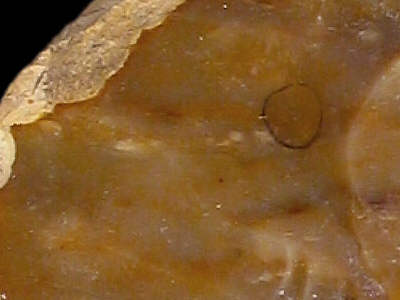
Foto: Jehanne Féblot-Augustins, 2005.
- St-André (Neuville-sur-Ain)
- Bassement
Sampled sites:
| Material name: | CN3b |
| Synonyms: | Silex Crétacé supérieur Nord - Sénonien |
| Material (geologic): | Late Cretaceous (Senonian) flint |

Foto: Jehanne Féblot-Augustins, 2005. |
Sampled sites:
|
| Mode of occurrence: | Small flat cobbles (8 cm long). |
| Cortex: | Thin (2 mm) alluvial neo-cortex, pale yellowish brown, transition sharp with a finely crenulated boundary. |
| Colour: | Brown with yellowish brown streaks (10YR 5/3.5). |
| Pattern: | Alignments of yellowish brown or pale tan specks, a few light millimetric inclusions. |
| Appearance: | Very homogeneous material with a greasy lustre, subtranslucent, smooth and very fine-grained. |
| Structure: | Faint fluidal arrangement of grains. |
| Texture: | Mudstone. |
| Matrix: | Semi-opaque. |
| Grains: | 5 to 10 %, pale or stained by iron oxides, rounded with high sphericity (50 to 100 µ); micritized clasts (500 to 2000 µ). |
| Grain composition: | Highly fragmented thin-walled sponge spicules, rare small globose and biserial foraminifera; iron oxides. |
| Further information: | Click here for the original French description (opens in a new window), or here for more information on the attributes used in the description (use your browser's "BACK"-button to return here). |
| Citing: | Information on citing this page can be found here. |
| Locality: | Neuville-sur-Ain / St-André, France, Ain department |
| Synonyms: | Sampling site Bugey 47 after Féblot-Augustins |
| Geographical description: | The material was collected near a slight rise within a large bend of the river "le Suran", just to the NW of St-André, some five kilometres west of Poncin. |
| Geographical co-ordinates: |
east/x 832,5 north/y 2124,8 (Lambert zone II, NTF)
This transforms as |
| Co-ordinate precision: |
The coordinates given were taken from a large-scale map, and are within approx. 50 metres of the actual spot. The latitude/longitude coordinates are a direct transformation of these data on WGS84 and are accurate to the same level, so don't be deceived by the apparently high precision to the second. The location can be found on the 1:25 000 topographical map sheet 3129 E of the French Institut Géographique National. |
| Geology: |
According to the geological map, the substrate belongs to unit RQ (P1), which consists of residual fluviatile deposits (attributed to the Late Pliocene) with quartzite — and more seldom flint — cobbles. Map of all sampled localities of Late Cretaceous flint in the Bugey (PDF, 54 KB, opens in new window). |
| Type of source: | Secondary. |
| Other types of flint: | Apart from the CN3b-flint described here, also several other flint-types of Senonian age can be found here: CN2a, CN2c, CN3a, and CN4c, as well as Early Cretaceous Ht3 silex. |
thumb.jpg) Foto: Jehanne Féblot-Augustins, 2005 |
| Locality: | Neuville-sur-Ain / St-André - Bassement, France, Ain department |
| Synonyms: | Sampling site Bugey 61 after Féblot-Augustins |
| Geographical description: | The sampling site lies in a small wooded valley half a kilometre to the south of the hamlet of Confranchette d'en Bas, which can be reached by following a narrow road for about a kilometre towards the southwest from St-Martin-du-Mont. |
| Geographical co-ordinates: |
east/x 832.3 north/y 2125.7 (Lambert zone II, NTF)
This corresponds roughly with |
| Co-ordinate precision: |
The location was documented on a large-scale topographical map, from which the French coordinates were taken. The latitude/longitude coordinates are a direct transformation of these data on WGS84 and rounded to the nearest arc-second. The location can be found on the 1:25 000 topographical map sheet 3129 E of the French Institut Géographique National. |
| Geology: |
The flint lies reworked in glacial deposits of Würmian age, unit "a" on the local geological map. Map of all sampled localities of Late Cretaceous flint in the Bugey (PDF, 54 KB, opens in new window). |
| Type of source: | Secondary. |
| Other types of flint: | Besides the CN3b-type, also the CN2a variety as well as CN2c flint can be found here. All flints originate in Late Cretaceous limestones, but were transported during the last Ice Age to their current position. |
thumb.jpg) Foto: Jehanne Féblot-Augustins, 2005 |
| Last modified on: November 25, 2005 |
Contents primarily by: Jehanne Féblot-Augustins |
Comments to: |